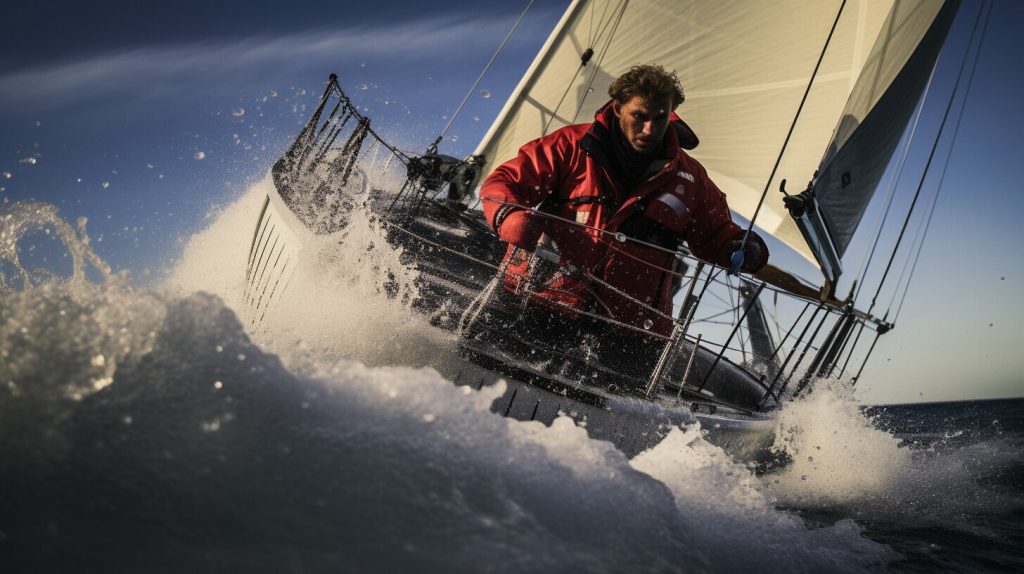Sailing enthusiasts know that excessive heeling can make for an uncomfortable and potentially dangerous experience on the water. When the boat leans over at an angle due to wind pressure on the sails, maintaining control becomes challenging. But fear not! With the right techniques and strategies, you can minimize sailing heeling and enjoy a smoother ride on the waves.
One of the key factors in reducing heeling is adjusting sail trim and course. By making small tweaks to the position of your sails and the direction of your sailboat, you can significantly improve its stability. Additionally, reefing, which involves reducing the sail area, is another effective technique for minimizing heeling. By properly using the reefing lines, you can control your sailboat’s stability and prevent excessive heel.
Flattening the headsail and furling it more can also contribute to a flatter sail shape and reduce heeling. These adjustments are crucial for maintaining a balanced and stable sailboat. Additionally, steering techniques play a vital role, especially when sailing in waves. By steering at the correct angle and making small inputs, you can keep the boat stable and prevent excessive heeling.
Sailing in cross waves requires specific techniques as well. Taking the favored gybe and waiting for the seastate to reduce can contribute to a more stable sailboat and reduced heel angle. Furthermore, to reduce rolling in waves, tightening the leech on the mainsail and spinnaker, as well as using a tweaker line, can make a significant difference.
Sailing downwind in light weather presents its own challenges, as maintaining boat speed becomes crucial. By implementing the right strategies, you can reduce heeling and enjoy a smoother downwind sailing experience.
Key Takeaways
- Adjusting sail trim and course is important for reducing heeling.
- Reefing can help minimize sail area and prevent excessive heel.
- Flattening the headsail and furling it more contributes to a flatter sail shape.
- Steering techniques are crucial for maintaining stability in waves.
- Taking the favored gybe and waiting for the seastate to reduce can enhance stability in cross waves.
Reducing rolling in waves can be achieved by tightening the leech on the mainsail and spinnaker and using a tweaker line. Lastly, when sailing downwind in light weather, anticipating wind direction and making necessary adjustments is key to maintaining consistent boat speed.
Adjusting Sail Trim and Course
One of the key factors in reducing heeling when sailing is to make adjustments to your sail trim and course. Properly adjusting the sails and steering can significantly improve the stability and control of your sailboat, creating a smoother and more enjoyable sailing experience.
When it comes to sail trim, small tweaks can make a big difference. Start by flattening the headsail to achieve a flatter sail shape. You can do this by moving the genny car back, which helps reduce the sail’s angle of attack and minimize heeling. Additionally, consider furling the headsail more to reduce the sail area exposed to the wind. This will not only reduce heeling but also help maintain a consistent boat speed.
Remember, when sailing downwind in waves, it is crucial to steer at a slight angle to the wave. This allows the boat to surf down the wave, increasing speed and reducing the chances of broaching or being rolled.
Steering techniques also play a significant role in reducing heeling. When sailing in waves that are not in the same direction as the wind, it is beneficial to take the favored gybe until the tide turns and the seastate reduces. This strategy helps maintain a more stable sailboat and reduces the heel angle. Additionally, when steering, it is essential to have a light touch with the rudder and make small, gradual steering inputs. This allows for better control and minimizes sudden movements that can contribute to excessive heeling.
To further reduce rolling in waves, consider tightening the leech on the mainsail and spinnaker. This helps maintain a flatter sail shape and reduces the chances of the boat rolling from side to side. Having a tweaker line to control the amount of twist in the spinnaker’s leech can also contribute to a more stable sailboat.
In conclusion, adjusting sail trim and course is crucial in reducing heeling when sailing. By making small adjustments to your sails, steering techniques, and sail area, you can achieve a flatter sail shape, maintain better control, and enjoy a smoother ride on the water.
Reefing to Reduce Sail Area
When the wind picks up, reefing your sails can help reduce the sail area and prevent excessive heeling. By reducing the amount of sail exposed to the wind, you can maintain better control over your sailboat and minimize the risk of capsizing.
One effective technique is to use the reefing lines on the clew of the main. These lines allow you to pull the sail down to the boom, reducing its size and maximizing your ability to manage the sail. By running the reefing line down to the boom, you can reduce windage and maintain stability in stronger winds.
Another method is to furl the headsail. By furling the headsail more tightly, you can decrease the sail area and minimize the force of the wind on the boat. This will help prevent excessive heeling and maintain a smoother ride on the water.
| Techniques for Reducing Sail Area | Benefits |
|---|---|
| Using reefing lines on the main | Improved control and reduced windage |
| Tightly furling the headsail | Minimized sail area and reduced heeling |
By implementing these strategies, you can confidently navigate challenging conditions and enjoy a more stable sailing experience. Remember to always assess the wind strength and adjust your sail plan accordingly to ensure the safety and comfort of your crew.
Flattening the Headsail and Furling
Achieving a flatter sail shape can significantly reduce heeling when sailing, and one way to accomplish this is by flattening the headsail and furling it. By adjusting the shape of the headsail, you can minimize the amount of sideways force generated by the wind, which in turn helps to maintain a more stable sailboat. Flattening the headsail involves tightening the halyard, moving the genny car back, and applying more tension to the furling line.
When the headsail is properly flattened, it creates a smoother flow of air over the sail, reducing the chances of an excessive heel angle. This technique is particularly effective when sailing upwind or in stronger winds, where the force on the sails is greater. By controlling the shape of the headsail, you can better manage the balance and stability of the sailboat.
To further reduce the sail area and control heeling, furling the headsail more can be beneficial. Furling involves rolling the headsail or genoa partially or completely, depending on the conditions. By reducing the exposed area of the sail, you decrease the force exerted by the wind and, consequently, the amount of heeling. It’s important to find the right balance between maintaining sail power and reducing heeling, depending on the wind strength and sea state.
Table 1: Summary of Techniques for Flattening the Headsail and Furling
| Technique | Description |
|---|---|
| Adjusting the halyard tension | Tighten the halyard to remove excess sag and create a flatter sail shape. |
| Moving the genny car back | Position the genny car closer to the stern to flatten the headsail and reduce heeling. |
| Applying tension to the furling line | Ensure the furling line is tight enough to maintain the desired amount of furling and reduce the exposed sail area. |
“Flattening the headsail and furling it are essential techniques for reducing heeling and improving the stability of your sailboat. By adjusting the shape of the headsail and reducing its sail area, you can better control the forces exerted by the wind. Experiment with different adjustments and find the right balance for the prevailing conditions. Remember, a flatter sail shape means a smoother ride and a more enjoyable sailing experience!”
Steering Techniques in Waves
When sailing in waves, it is crucial to employ specific steering techniques to minimize heeling and keep the boat stable. As the waves impact the boat, it’s important to steer at a slight angle to the wave, allowing the boat to surf down the wave and increase speed. This angle helps reduce the chances of broaching or being rolled by the wave. Maintaining a light touch on the rudder and making small steering inputs is key to maintaining stability.
One technique to effectively navigate waves is to anticipate the wave’s direction and adjust the boat’s course accordingly. By anticipating the wave’s movement, you can steer the boat in a way that allows it to ride over the waves smoothly, reducing heeling and maintaining stability. Keeping a watchful eye on the wave patterns and adjusting your steering technique accordingly will greatly enhance your sailing experience in waves.
Sailing Techniques for Stability in Waves
Another technique to improve stability in waves is to make use of techniques like the favored gybe. When sailing in waves that are not in the same direction as the wind, taking the favored gybe can help maintain stability. By waiting for the tide to turn and the seastate to reduce, you can sail in a more controlled and stable manner, reducing heel angle and ensuring a smoother ride.
It is also essential to keep the sail trim and sail area in check when sailing in waves. Maintaining a flatter sail shape by flattening the headsail and moving the genny car back helps reduce the sail’s surface area exposed to the wind, leading to lesser heeling. Additionally, tightening the leech on the mainsail and spinnaker helps reduce rolling in waves. Having a tweaker line to control the amount of twist in the spinnaker’s leech further enhances stability and minimizes heel angle.
Steering techniques in waves play a vital role in reducing heeling and keeping the boat stable. By employing these techniques and making the necessary adjustments to sail trim and course, you can confidently navigate through challenging wave conditions and enjoy a smoother sailing experience.
Sailing in Cross Waves
Sailing in waves that are not aligned with the wind requires specific strategies to maintain stability and minimize heeling. When the waves are coming from a different direction than the wind, it can create a challenging sailing experience. However, with the right techniques, you can navigate through cross waves smoothly.
To sail effectively in cross waves, it is beneficial to take the favored gybe. By adjusting your course to take advantage of the wave direction, you can maintain better control of your sailboat. Waiting for the seastate to reduce can also contribute to a more stable ride, as calmer waters will minimize the impact of the cross waves.
When sailing in cross waves, it’s important to anticipate the motion of the boat and make small steering inputs. Keeping a light touch on the rudder will help you maintain stability and prevent excessive heeling. By being attentive and responsive to the changing conditions, you can navigate through cross waves with confidence.
Table: Techniques for Sailing in Cross Waves
| Technique | Benefits |
|---|---|
| Take the favored gybe | Improve stability and control |
| Wait for seastate to reduce | Minimize impact of cross waves |
| Make small steering inputs | Maintain stability and minimize heeling |
By implementing these strategies and techniques, you can navigate through cross waves more effectively and reduce the risk of excessive heeling. Remember to always prioritize safety and adjust your sail trim and course accordingly to maintain stability in challenging conditions.
To minimize rolling when sailing in waves, certain adjustments can be made to the mainsail and spinnaker to enhance stability. One effective technique is tightening the leech on both the mainsail and spinnaker. By doing so, you can control the amount of twist in the sail, reducing the chances of excessive rolling. Additionally, using a tweaker line for the spinnaker allows for further control over the leech, maximizing stability even in challenging wave conditions.
When adjusting the leech of the mainsail, it is important to maintain balance and avoid over-tightening, as this can hinder performance and responsiveness. Find the sweet spot where the sail maintains a flat shape while still allowing sufficient power to propel the boat forward. This balance will ensure stability while also optimizing speed.
Another technique to reduce rolling is to furl the headsail more. By reducing the sail area, you decrease the surface exposed to the wind, minimizing the boat’s tendency to heel and roll. While it’s crucial to maintain sufficient sail power for forward momentum, adjusting the headsail appropriately can significantly improve stability in wave conditions.
When implementing these techniques, always keep in mind the importance of adapting to the current sea state and wind conditions. By anticipating changes and making adjustments accordingly, you can maintain a smoother and more stable sailing experience.
- Stay light on the rudder and make small steering inputs to maintain control and minimize rolling.
- Take the favored gybe when sailing in waves that are not in the same direction as the wind until the tide turns and the sea state reduces. This strategy helps improve stability and reduces the boat’s heel angle.
- Always monitor the wind direction and adjust your course to avoid gusts or dead spots, ensuring consistent boat speed even in light weather conditions.
By implementing these techniques and strategies, you can reduce rolling and maintain stability when sailing in waves. Remember to always prioritize safety and adapt your sailing techniques to the prevailing conditions. With practice and experience, you’ll become adept at minimizing heel angle and enjoy a smoother and more enjoyable sailing experience.
“Sailing is not just about the destination, but the journey itself. By mastering the art of stability in waves, you can turn every sailing adventure into an unforgettable experience.” – Anonymous Sailor
Sailing Downwind in Light Weather
When sailing downwind in light weather, it is crucial to anticipate wind changes and make the necessary adjustments to control heeling. In these conditions, the swell can have a significant impact on the wind, making it challenging to maintain consistent boat speed. To navigate this situation successfully, there are a few key strategies you can employ.
Firstly, it’s important to keep a close eye on the wind direction. Light winds are often fickle, and even small shifts can affect your boat’s performance. By constantly monitoring the wind, you can anticipate changes and make timely adjustments to your sail trim. This will help you maintain a balanced sail plan and prevent excessive heeling.
Secondly, you may need to make adjustments to your course. In light weather, the swell can often kill the wind, making it necessary to find areas with better wind flow. By steering your boat slightly off course to catch the wind, you can maximize your speed and reduce the chances of heeling. Remember to have a light touch on the rudder and make small, precise steering inputs for optimal control.
Lastly, maintaining a consistent boat speed is essential when sailing downwind in light weather. Any loss of speed can significantly affect your ability to control heeling. Keep a close eye on your boat’s speed and make adjustments accordingly. By optimizing your sail trim, course, and speed, you can effectively manage heeling and enjoy a smoother sailing experience.
| Strategies | Benefits |
|---|---|
| Anticipate wind changes | Control heeling and maintain optimal sail performance |
| Adjust course to find better wind flow | Maximize boat speed and reduce chances of heeling |
| Maintain consistent boat speed | Optimize control over heeling and enjoy a smoother sailing experience |
Remember, when sailing downwind in light weather, it’s all about adapting to the changing conditions and making the necessary adjustments. By staying alert and employing these strategies, you can master the art of controlling heeling and enjoy a more enjoyable and stable sailing experience.
Conclusion
By adjusting sail trim, reefing when necessary, employing proper steering techniques, and following the strategies outlined in this article, you can significantly reduce heeling and enjoy a smoother sailing experience. Heeling, which occurs when a sailboat tilts due to wind pressure on the sails, can be mitigated by making small adjustments to sail trim and course. Flattening the headsail and furling it more can help achieve a flatter sail shape, while using the reefing lines on the main sail allows for better control. When sailing in waves, it is important to steer at a slight angle to ride the waves and make small steering inputs for stability.
When waves are not in the same direction as the wind, taking the favored gybe until the tide turns and the seastate reduces can contribute to a more stable sailboat. To reduce rolling in waves, tightening the leech on the mainsail and spinnaker and using a tweaker line can help control the sail’s twist. Sailing downwind in light weather requires anticipating wind direction and making adjustments to maintain consistent boat speed. With these techniques and strategies in mind, you can prevent excessive heeling and enjoy a smoother ride on the water.
FAQ
Q: What is heeling in sailing?
A: Heeling in sailing refers to the boat leaning over at an angle due to wind pressure on the sails.
Q: How can I reduce heeling when sailing?
A: To reduce heeling, it is important to adjust sail trim, adjust course, and reduce sail area through reefing. Flattening the headsail and moving the genny car back can help achieve a flatter sail shape. Furled the headsail more to reduce the sail area. The reefing line on the clew of the main should be run down to the boom to allow for better control of the sail. Pulling the reef down to the boom helps reduce windage.
Q: What steering techniques should I use when sailing in waves?
A: When sailing downwind in waves, it is important to steer at a slight angle to the wave so that the boat can surf down the wave, increasing speed and reducing the chances of broaching or being rolled. It is also important to have a light touch with the rudder and make small steering inputs.
Q: How can I reduce rolling in waves?
A: To reduce rolling in waves, it is helpful to tighten the leech on the mainsail and spinnaker and have a tweaker line to control the amount of twist in the spinnaker’s leech.
Q: What should I do when sailing downwind in light weather?
A: Sailing downwind in light weather can be challenging, as the swell can kill the wind. It is important to anticipate the wind direction and make adjustments to maintain consistent boat speed.










